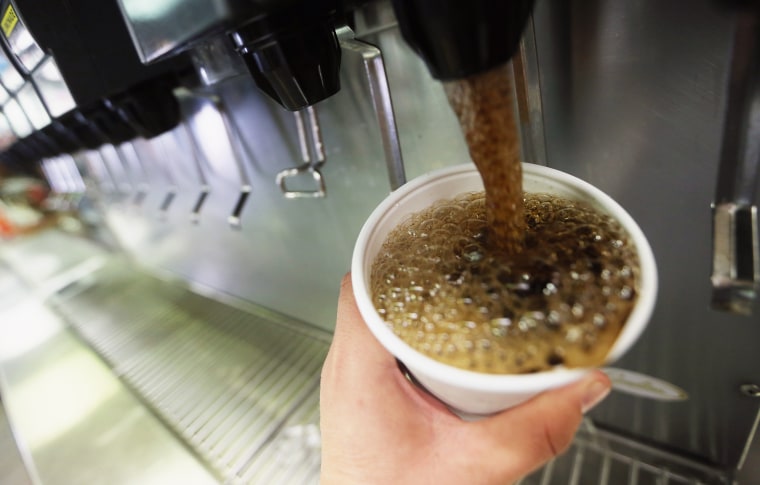Will soda soon fizz out in America?
Already slogging through a decade-long sales decline, more bad news soaked the soft drink sector in recent weeks. A new study claimed sipping soda ages you as fast as smoking cigarettes. Coca-Cola reported a 14 percent profit dip. Then, Friday, reports surfaced that the man who played Santa Claus in some of Coke’s TV ads had died — sad, but also perhaps a touch symbolic.
If soft drinks are similarly bound for product purgatory, how long until the soda bubble finally bursts — for good?
At PepsiCo, CEO Indra Nooyi warned in 2013 that a breakthrough in natural soda sweeteners was desperately needed because: “If you let this go too long, another three or five years, the consumer will walk away.”
And for Coca-Cola — the U.S. market-share leader (44 percent) over Pepsi (28 percent) and Dr. Pepper Snapple (17 percent) — some industry experts raise higher concerns about mass consumer desertion. Why? Carbonated drinks compose about 60 percent of Coke’s U.S. sales, the Washington Post has reported. Compare that to Pepsi, where soft drinks make up only about 25 percent of U.S. sales as that company branches deeper into food products.
“Most of (Coca-Cola’s) business is in trouble. That’s a big issue,” said Dean Crutchfield, a New York-based brand consultant who lists PepsiCo among his past clients. “Coca-Cola also is targeted (most often) by wellness advocates as 'what not to drink.'”
“You hear lot of people at Coca-Cola say they’re really put out because their brand seems to be the only one used (by nutritional watchdogs) to illustrate the issue, that Coca-Cola is the bad boy,” Crutchfield added. “It’s like, well, yeah, because you’re the biggest in the category. But your brand also has to be responsible, especially in these health-conscious times.”
"Suggesting the soft drink market will be gone in 5 or 10 or 15 years is wildly inaccurate."
That dire dissection aside, Crutchfield applauds some of Coke’s recent marketing moves, including positioning its brand as “a treat, instead of the old days where they wanted you guzzling it in liters every day.”
A recent Coke ad, he said, hits that mark: A red balloon (colored like the can) drifts upward outside a city building, past windows showing different residents arriving at birthday party or throwing a surprise 50th anniversary party. All of the celebrants have Cokes in hand.
“Let’s not forget, Coca-Cola is the best marketer out there. By far,” Crutchfield said. “When they get it right, they get it right. For so long, they seemed to have a very sophisticated marketing operation. That’s changed — not because of them. But they’ve been late to (meet the) change. And if you don’t like change, you’re going to like irrelevance even less.”
At its Atlanta headquarters, Coca-Cola’s leaders respond by citing their successful, summer ad campaign “Share a Coke,” during which the logos on bottles were replaced with popular names of many young Americans. That idea, Coke officials reported, generated more 125,000 social media posts in June and early July.
In August, the brand also unveiled Coca-Cola Life — a reduced-calorie cola sweetened with cane sugar and stevia leaf extract, containing about 35 percent fewer calories than other top colas.
“We firmly believe we can reinvigorate growth in the sparkling category in North America,” said Katie Condon, a Coke spokeswoman. “We know after 128 years that we have to follow consumers. When we do, we win. And consumers are telling us they want more choices, more often and smaller package sizes … It is early in the journey, but we are optimistic about where we are going.”
At PepsiCo headquarters in Purchase, New York, officials address the soda slide by highlighting the brand’s continued move away from that sector.
Since 2006, PepsiCo has acquired Naked Juice and dairy giant Wimm-Bill-Dann. Today, 20 percent of PepsiCo’s global revenue comes from its nutrition businesses, and more than half its North American revenue is derived from non-carbonated beverages such as tea, coffee, sports drinks and juice.
“PepsiCo anticipated the consumer shift towards health and wellness more than two decades ago and proactively began to transform its portfolio,” said PepsiCo spokeswoman Andrea Canabal.
While Coke recently reported a profit loss, PepsiCo reported in October a 5 percent bump in net income from the previous year. Dr. Pepper Snapple reported in October a 6 percent increase in income from the prior year.
For soda products more generally, some consumers seemed to begin falling out of love with the bubbly drinks in about 2000 — following a decade when the soda business was still growing at about 3 percent per year, said John Sicher, editor and publisher of Beverage Digest, which covers the industry.
"For the past 10 years the soft drink business has been in decline," Sicher said.
The downtown was initially fueled by the appearance of bottled water in the mid- to late-1990s, he said. Consumers loved it. Then, soft drink prices climbed. Consumers didn’t love that. Next, health advocates began railing against empty soda calories — a grim market mix for Coke and Pepsi.
“Consumers began to diversify their beverage tastes and began drinking more ready-to-drink tea, sports drinks,” Sicher said.
Carbonated soft drink volume sank by 3 percent in 2013, following a 1.2 percent decrease in 2012 and a 1 percent drop in 2011, Beverage Digest reported. (Figures for 2014 are not yet available).
“The companies are now alerted of the need to innovate. They are working hard in that direction,” Sicher said. “They’ve got some of the biggest, most powerful brands, literally, in the world. And they’ll be able to use those brands on new products like Coke Life, and Pepsi True — (a drink with 60 calories, sweetened by sugar and Stevia).
“Suggesting the soft drink market will be gone in 5 or 10 or 15 years is wildly inaccurate,” he added. “We’re just at the start of a decade of innovation, at the very start of the trajectory.”
